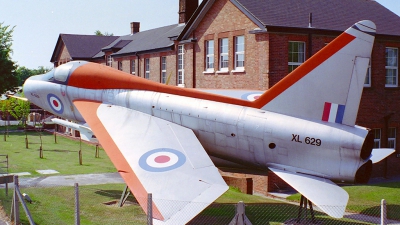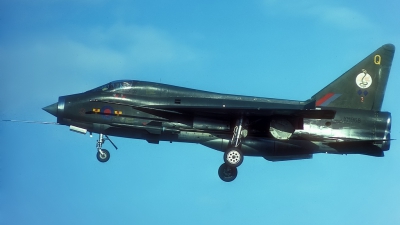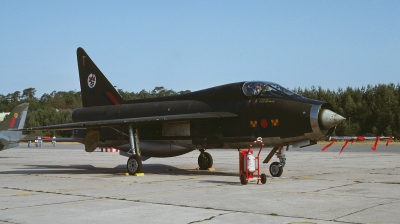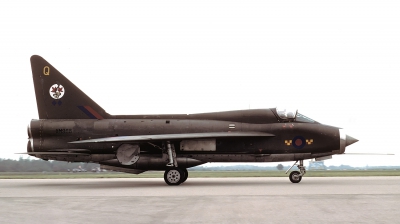English Electric Lightning T4 Aircraft Data
The Lightning T.4 was conceived as the dual-seat training and conversion variant of the F.1A and as such was fitted with dual flight and engine controls as well as twin radar displays. The student-pilot and instructor were seated side-by-side in Martin Baker Mk.4BS ejection seats.
The performance of the T.4 was almost identical to the single-seat aircraft and in terms of weaponry only lacked the twin 30mm Aden cannon.
The original requirement for 30 T.4 aircraft was later reduced to twenty, with the first of these, XM970 entering RAF service with the Lightning Conversion Squadron (LCS) at RAF Middleton St. George on 29 June 1962.
Two prototype Lightning T.4 aircraft were constructed by English Electric at their Preston/Samlesbury works. The first of the two, XL628 (c/n 95049), made her first flight in the hands of R.P. Beamont on 6 May 1959. A mere five months into the test and development programme the aircraft was lost on 1 October 1959. During a supersonic flight over the Irish Sea, the aircraft suffered a structural failure of the fin. The pilot, J.W.C. 'Johnny' Squier, ejected safely, but had to endure over 28 hours in the cold Irish Sea before drifting ashore in Wigton Bay, Scotland. The early two-seat aircraft suffered from structural weakness in the fins. After the loss of XL628, the prototype T.5 (XM966) crashed into the Irish Sea on 22 July 1965, as its fin disintegrated during a high speed test flight. Fortunately, both occupants, test pilot J.L. 'Jimmy' Dell and flight test engineer Graham Elkington survived.
Lightning T.4 production, serials and construction numbers
XL628 and XL629 (c/n 95049 and 9550) were to serve as prototype aircraft.
Twenty aircraft were constructed for the Royal Air Force. These machines were serialled XM966 to XM970 (c/n 95051 to 95055); XM971 to XM974 (c/n 95071 to 95074); XM987 to XM992 (c/n 95075 to 95080); XM993 to XM996 (c/n 95100 to 95103) and finally XM997 (c/n 95111).
Of these aircraft XM966 and XM967 were converted to T.5 to serve as prototypes, whilst XM992 was converted to T.54 standard for the Royal Saudi Air Force (serial 54-651).
The serials allocated to the cancelled 10 T.4's were: XN103 to XN112.
The Lightning T.54 was in fact a slightly modified version of the RAF T.4, with most of the mods related to the cooling system, similar to those in the F.52 aircraft delivered to the RSAF.
The performance of the T.4 was almost identical to the single-seat aircraft and in terms of weaponry only lacked the twin 30mm Aden cannon.
The original requirement for 30 T.4 aircraft was later reduced to twenty, with the first of these, XM970 entering RAF service with the Lightning Conversion Squadron (LCS) at RAF Middleton St. George on 29 June 1962.
Two prototype Lightning T.4 aircraft were constructed by English Electric at their Preston/Samlesbury works. The first of the two, XL628 (c/n 95049), made her first flight in the hands of R.P. Beamont on 6 May 1959. A mere five months into the test and development programme the aircraft was lost on 1 October 1959. During a supersonic flight over the Irish Sea, the aircraft suffered a structural failure of the fin. The pilot, J.W.C. 'Johnny' Squier, ejected safely, but had to endure over 28 hours in the cold Irish Sea before drifting ashore in Wigton Bay, Scotland. The early two-seat aircraft suffered from structural weakness in the fins. After the loss of XL628, the prototype T.5 (XM966) crashed into the Irish Sea on 22 July 1965, as its fin disintegrated during a high speed test flight. Fortunately, both occupants, test pilot J.L. 'Jimmy' Dell and flight test engineer Graham Elkington survived.
Lightning T.4 production, serials and construction numbers
XL628 and XL629 (c/n 95049 and 9550) were to serve as prototype aircraft.
Twenty aircraft were constructed for the Royal Air Force. These machines were serialled XM966 to XM970 (c/n 95051 to 95055); XM971 to XM974 (c/n 95071 to 95074); XM987 to XM992 (c/n 95075 to 95080); XM993 to XM996 (c/n 95100 to 95103) and finally XM997 (c/n 95111).
Of these aircraft XM966 and XM967 were converted to T.5 to serve as prototypes, whilst XM992 was converted to T.54 standard for the Royal Saudi Air Force (serial 54-651).
The serials allocated to the cancelled 10 T.4's were: XN103 to XN112.
The Lightning T.54 was in fact a slightly modified version of the RAF T.4, with most of the mods related to the cooling system, similar to those in the F.52 aircraft delivered to the RSAF.
- Country of Origin: United Kingdom
- First Flight: 6 May 1959
- Initial Service Date: 29 June 1962
- No. Built: 20
- No. In Service: 0
- No. of Hardpoints: 2
- Crew: 2
Power:
2 Rolls Royce RA.24R Avon Mk.210R at 11,250 lbf
Weapons:
Two De Havilland Firestreak air-to-air missiles.
Dimensions:
| Length: | 55 ft 3 in. |
| Wing Span: | 34 ft 10 in. |
| Wing Area: | 458,5 sq.ft |
| Height: | 19 ft 7 in. |
| Empty Weight: | 27,000 lbs |
| Max. Weight: | 34,500 lbs |
Performance:
Operators:
United KingdomSaudi Arabia (T.54)

 Random great photos of the English Electric Lightning T4:
Random great photos of the English Electric Lightning T4:


